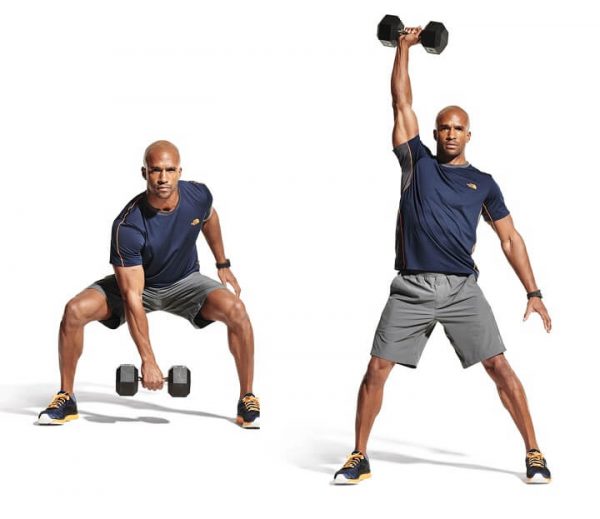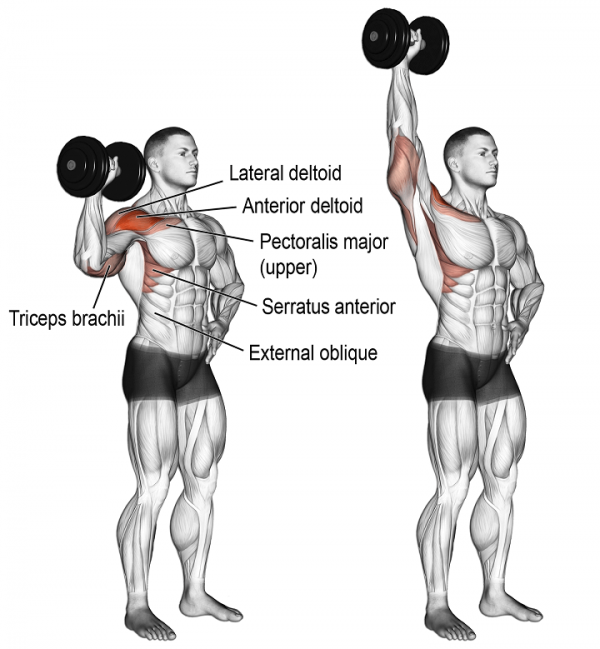Unilateral training (lifting with only one arm or one leg) is important. The problem is, we have some coaches who say it’s a waste of time while others limit their unilateral training to just the lower body. The former group is just plain wrong and the latter group is shortchanging their athletes.
How often have you been doing a squat or bench press only to find one side rising before the other? That’s a potential red flag for muscular imbalance. Single-limb exercises force you to recruit more core muscles to stabilise the spine and transfer load in ways that are neglected by bilateral lifts.
The maximum force you can exert bilaterally is less than the sum of two individual limbs working separately. Essentially, if you can bench press 70-pound dumbbells but get plastered by a 135-pound barbell, that’s indicative of a bilateral deficit.
Whatever the cause of the deficit, if a muscle is receiving more overload with the dumbbell movement, then it’s beneficial to use exercises that do just that.

Strength is a skill that needs constant refinement. So, totally abandoning bilateral lifts for unilateral lifts isn’t a great strategy to improve the big compound movements. However, incorporating unilateral lifts into a balanced plan recruits previously untapped motor units for strength, power, and muscular development.
By improving motor unit recruitment, you’ll have a greater number of muscle fibers at your disposal for your big lifts.
Here are the five best upper-body unilateral exercises that build muscle and strength.
1. Single-Arm Dumbbell Snatch
Snatches build world-class power and a thick set of traps. The problem is, most lifters sit in a constant kyphotic position and look more like the hunchback of Notre Dame than an athlete. Coupled with push dominant training and poor mobility/stability, barbell snatches can leave the shoulders feeling torn apart.
The single-arm dumbbell snatch is the perfect middle ground. You get explosive hip extension plus unilateral overhead strength in a more shoulder-friendly position. As an added benefit, single arm-overhead work forces your quadratus lumborum to kick in (an aid in trunk stabilisation) and crushes your obliques.

How to do it:
- Start with a dumbbell between your legs in the hang position.
- Propel the dumbbell upwards by driving through your heels and fully extending the hips.
- Drive the elbow high and catch the dumbbell overhead with the knees slightly bent.
2. Single-Arm Push Press
Overhead presses are excellent for developing total body strength and stability. Taken a step further, the push press – using a dip and leg drive – teaches you to generate force through the lower body before transferring the force to the upper body and stabilising everything from your wrist to ankle.
Unfortunately, due to shoulder mobility and stability restrictions, barbells aren’t conducive to excellent shoulder health. By replacing the barbell with a dumbbell, you can press overhead through a natural range of motion to build stability while developing explosive total body power.

How to do it:
- Stand tall with a dumbbell held at shoulder height.
- Rapidly dip into a quarter squat and then reverse momentum and perform an explosive overhead press, squeezing your glutes for stabilisation and locking the press overhead before lowering the weight back to your shoulders.
3. Dumbbell Split Row
Dumbbell rows are an excellent horizontal pulling exercise, but most lifters look like they’re trying to pull-start a lawn mower when they do them. This severely limits the bang-for-your buck benefits of single-arm rows. More often than not, torso rotation replaces scapular retraction as the primary mover of the weight.
To maximize reward and minimize risk, you need to adopt a split stance and stand perpendicular to the bench. This slight change allows you to row huge weight for strength and mass while significantly increasing the anti-rotation and anti-flexion demands of your typical row. This builds an injury resistant trunk while allowing you to hoist heavy weights for better pulling strength.

How to do it:
- With a heavy dumbbell in one hand, lock the opposite arm out on a bench and hold a flat back position.
- Keep the feet slightly staggered and row the dumbbell up towards your ribcage while preventing your torso from twisting and rotating.
4. One-Arm Dumbbell Bench Press
It’s common to see pressing imbalances, specifically on horizontal presses like the bench. Combining huge muscular imbalances with heavy barbell lifts goes together as well as getting kicked in the nuts and fired in the same day. As such, they’re best kept separate.
One-arm dumbbell bench presses, however, give you the option to train each “press” individually, bringing up weak points in the shoulders, triceps, and pecs. Beyond the basic muscles used in any press, the unilateral load simultaneously forces your core to stabilize your body to prevent you from corkscrewing off the bench.

How to do it:
- Sit down on a bench with one dumbbell resting on your thigh.
- Kick the weight to the shoulder and lie back, positioning the dumbbell to the side of your chest with the forearm and upper arm forming a 90-degree angle under the dumbbell.
- Screw your feet into the ground and put your non-working hand on your hip to stabilize your core.
- Explosively press the dumbbell up until the elbow is fully extended and then lower the weight back under control just outside the chest.
5. One Arm Locked Dumbbell Bench Press
This is both a unilateral and a bilateral exercise. The 1-1-2 press combines a unilateral bench press with a bilateral dumbbell press. What happens is that the unilateral press forces single-limb stabilisation, thus improving motor unit recruitment in that limb and stabilizing the trunk to prevent you from falling off the bench.
Each set takes a long time too, meaning that the time under tension is increased to boost muscular and metabolic damage, both key components in triggering muscle growth.

How to do it:
- Set up for a normal dumbbell bench press with each arm holding a dumbbell over the chest.
- Keep one arm locked out and your eyes on that stationary dumbbell.
- Perform a one-arm press, then alternate and press with the opposite arm.
- Once both dumbbells have been pressed unilaterally, press them at the same time like a conventional dumbbell bench press.
- This is one complete rep.
- These are best done in a hypertrophy routine or as a finisher.
- Use a weight you’ll typically press for 10-12 reps and perform 5-8 full reps.

